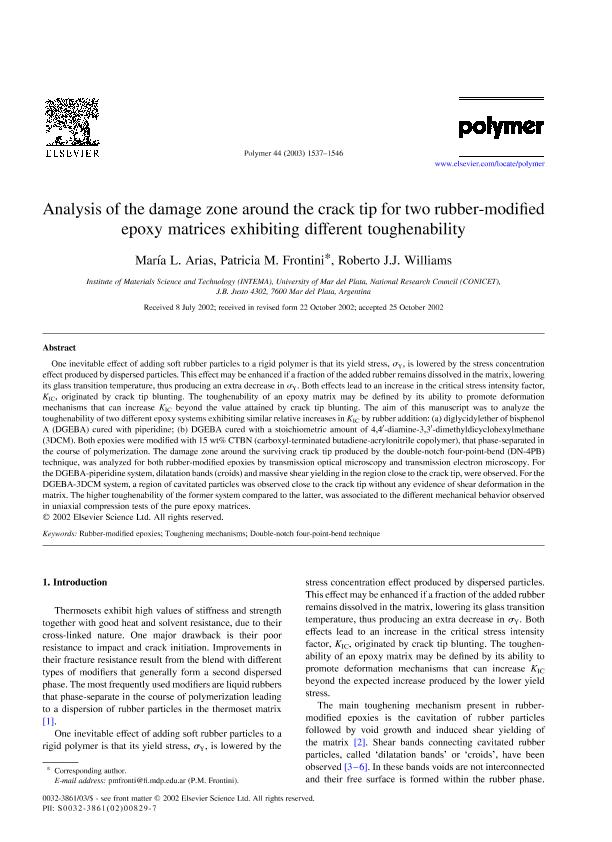Artículo
Analysis of the damage zone around the crack tip for two rubber-modified epoxy matrices exhibiting different toughenability
Fecha de publicación:
02/2003
Editorial:
Elsevier
Revista:
Polymer
ISSN:
0032-3861
Idioma:
Inglés
Tipo de recurso:
Artículo publicado
Clasificación temática:
Resumen
One inevitable effect of adding soft rubber particles to a rigid polymer is that its yield stress, σY, is lowered by the stress concentration effect produced by dispersed particles. This effect may be enhanced if a fraction of the added rubber remains dissolved in the matrix, lowering its glass transition temperature, thus producing an extra decrease in σY. Both effects lead to an increase in the critical stress intensity factor, KIC, originated by crack tip blunting. The toughenability of an epoxy matrix may be defined by its ability to promote deformation mechanisms that can increase KIC beyond the value attained by crack tip blunting. The aim of this manuscript was to analyze the toughenability of two different epoxy systems exhibiting similar relative increases in KIC by rubber addition: (a) diglycidylether of bisphenol A (DGEBA) cured with piperidine; (b) DGEBA cured with a stoichiometric amount of 4,4′-diamine-3,3′-dimethyldicyclohexylmethane (3DCM). Both epoxies were modified with 15 wt% CTBN (carboxyl-terminated butadiene-acrylonitrile copolymer), that phase-separated in the course of polymerization. The damage zone around the surviving crack tip produced by the double-notch four-point-bend (DN-4PB) technique, was analyzed for both rubber-modified epoxies by transmission optical microscopy and transmission electron microscopy. For the DGEBA-piperidine system, dilatation bands (croids) and massive shear yielding in the region close to the crack tip, were observed. For the DGEBA-3DCM system, a region of cavitated particles was observed close to the crack tip without any evidence of shear deformation in the matrix. The higher toughenability of the former system compared to the latter, was associated to the different mechanical behavior observed in uniaxial compression tests of the pure epoxy matrices.
Archivos asociados
Licencia
Identificadores
Colecciones
Articulos(INTEMA)
Articulos de INST.DE INV.EN CIENCIA Y TECNOL.MATERIALES (I)
Articulos de INST.DE INV.EN CIENCIA Y TECNOL.MATERIALES (I)
Citación
Franco Arias, Lina Maria; Frontini, Patricia Maria; Williams, Roberto Juan Jose; Analysis of the damage zone around the crack tip for two rubber-modified epoxy matrices exhibiting different toughenability; Elsevier; Polymer; 44; 5; 2-2003; 1537-1546
Compartir
Altmétricas




